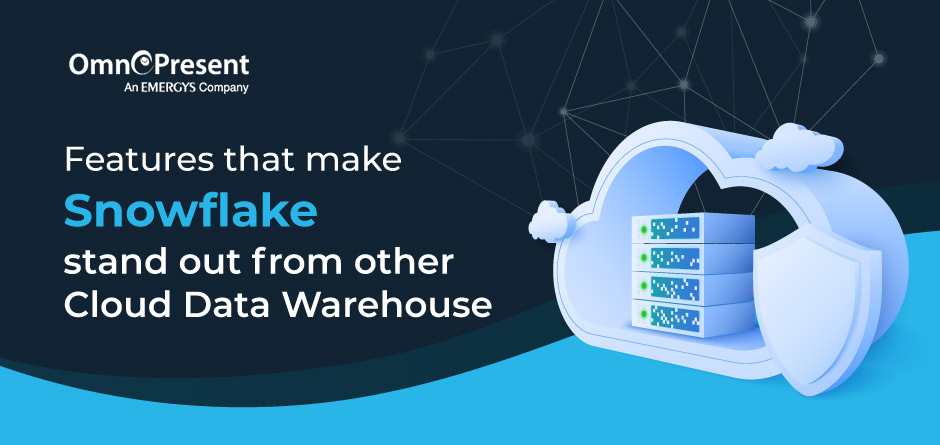
Features that make Snowflake stand out from other Cloud Data Warehouse
Data is a core asset for modern enterprises, but technological innovation has made data management much more complicated. Enterprises seeking to stay competitive must identify the best data platform that can handle the massive volumes of data they’re generating and provide reliability, speed, ease of use, and availability. In the world of data warehousing, there are many different options to choose from. However, one option that has been gaining popularity lately is Snowflake. It’s built on top of Microsoft Azure or Amazon Web Services cloud infrastructure and allows storage capacity and computational power to scale independently.
In this blog post, we will explore some of the features that make Snowflake stand out from the competition. From its unique architecture to its ability to handle diverse data types, Snowflake is quickly becoming the go-to choice for many businesses. Read on to learn more about what makes Snowflake so special and why you should consider it for your next data warehouse needs.
What is Snowflake?
Snowflake is a cloud-based data warehouse that offers a single platform for all of your data needs. This includes data warehousing, data lakes, data engineering, data science, and application development. It also comes with features like separation of storage and computes, on-the-fly scalable computing–allowing you to grow at your own pace–data sharing, and third-party tools support. With Snowflake, growing enterprises can focus on innovation rather than maintenance. Snowflake automatically scales up or down for optimal performance and cost. This is because Snowflake separates compute from storage, unlike other databases such as Redshift, which combine both together. With Snowflake, you can store your data in a single place.
One key feature is its ability to scale horizontally, which means it can handle increasing amounts of data without compromising performance. Additionally, Snowflake offers a “pay as you go” pricing model, which allows users to only pay for the storage and computing resources they use.
Snowflake Features and Capabilities
With digital transformation, healthcare providers can improve patient management, streamline workflows, leverage patient data, and provide a more personalized patient experience. However, finding a reliable technology partner is becoming more challenging due to the growing need for custom application development.
Snowflake is a cloud-based data warehouse that offers many features and capabilities that set it apart from the competition. Snowflake’s unique architecture enables it to scale elastically, meaning it can easily accommodate changing demands without compromising performance. This makes it ideal for businesses that experience fluctuating or unpredictable workloads.
Another key feature of Snowflake is its multi-cluster sharing architecture, which allows multiple warehouses to share data without replicating it. This not only saves space and storage costs, but also makes it easy to keep data synchronized across different warehouses.
Snowflake also offers a number of security features, such as role-based access control, which helps ensure that only authorized users have access to sensitive data. In addition, Snowflake’s encryption capabilities protect data both at rest and in transit, making it one of the most secure data warehouses available.
Features that make Snowflake different from other Cloud Data warehouse:
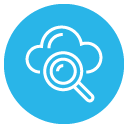
Cloud Agnostic Solution
Snowflake is a solution that’s available on all three cloud providers such as AWS, Azure, and GCP, while maintaining the same user experience. By easily fitting it into an existing architecture, customers have the flexibility to implement Snowflake in any region that works for their organization.

Scalability
The Snowflake multi-cluster data architecture includes separate compute and storage resources. This design enables users the ability to ramp up their computer and data storage when they need it and scale back down when they’re done without ever having to worry about interrupting service. Customers can start with an extra small virtual warehouse and upgrade as they need to at any time.
Snowflake has two great features called auto-scaling and auto-suspend that enable the platform to meet your processing needs. Auto-scaling automatically starts and stops clusters during unpredictable moments when a lot of work is required, and auto-suspending stops the warehouse when clusters have been idle for a while. These two concepts provide flexibility, performance optimization, as well as cost management.

Security
Snowflake is great because it offers a number of security features that you can use to keep your data safe. You can restrict which IP addresses have access with whitelists, and Snowflake supports various handshakes including two-step verification and support for federated authentication. Snowflake also has flexible ownership policies – each object has an owner who grants access, and roles are handled with role-based permissions. This ensures educated and calculated risk while using the program. All data is automatically encrypted and sent over ports with 256-bit strong encryption, ensuring that it’s both secure in transit as well as at rest.
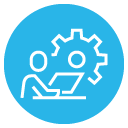
Near-Zero Administration
Snowflake is a Data Warehouse as a service (DWaas) and it enables companies to set up their own solution without significant involvement from a DBA or IT team. It doesn’t need software to be installed or hardware to be commissioned. It features modern features like auto scaling, which will increase the virtual warehouse size and cluster size without any manual intervention on your end. It supports no indexes, so there’s no need to create indexes for tables or manage clusters. Snowflake can take care of software updates automatically, so you don’t have to worry about installing them. New features are deployed with zero downtime–you’ll never have to update the database.
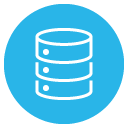
Data-Clustering
When data is inserted into Snowflake, it will be grouped together with data that has a similar range of values. This process happens in multi-partitions, or what is called micro-partitions. By clustering like data together, Snowflake can easily avoid scanning entire micro-partitions when certain values don’t exist.
Snowflake not only automates clustering on your tables, but it also triggers its natural clustering process in most cases. This clustering is more accurate than others and performs well even when you have bigger tables.
If you want to do manual clustering it can be done based on the concept of clustering key which can be defined on the table by the user. This is mainly used when you have very large tables. In this case, you can use Snowflake’s concept of the clustering key which gives you control over table clustering.
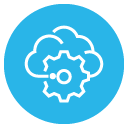
Support for Semi-structured Data
Snowflake is one of the few solutions that can support structured and semi-structured data without using complex systems like Hadoop or Hive. Snowflake also supports semi-structured data ingestion in a variety of formats, including JSON, Avro, ORC, Parquet, and XML. It stores data in columnar format and extracts as much as possible and stores leftovers in a single column. The app also utilizes functions that parse, extract, cast, and manipulate the data.
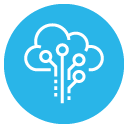
Continuous Data Pipelines
Snowflake is a powerful tool that automates many of the manual steps involved with transforming data. Snowflake includes features such as continuous data ingestion, change tracking and set up for recurring tasks–all which help to build a workflow for your continuous data pipelines.
Snowpipe is Snowflake’s continuous data ingestion service. It provides a pipeline for loading fresh data in batches of micro-batches, making it available to you within minutes rather than having to load larger batches of data manually with the ‘COPY’ statement.
Snowpipe leverages event notifications from other stages to let it know when new data is available. It then copies this data into its queue and loads it into Snowflake. Because of the REST endpoint, applications can call Snowpipe with a list of filenames that need to be ingested. This way, the application doesn’t have to stay active while Snowflake ingests the data.
Copying new data from staging tables to other tables can be difficult if you don’t know which data has changed. Snowflake table streams help with that, by capturing metadata about changes made to your table so that only the most recent row is copied over. This technique is also known as change data capture.
Tasks are a feature that allows your team to schedule SQL statement executions. They can either execute single statements or call stored procedures. Tasks are really useful for periodic work, like running a report on new data or as part of data pipelines that capture recently changed table rows and transform them for insertion into other tables.

Recovering objects using undrop
If you ever drop the wrong table, don’t fret! The UNDROP command is here to help. Whenever your data is lost due to a DROP statement, the command tries to recover it for you within the recovery window as long as it was enabled at the time of drop.

Zero-copy clones
In traditional data warehousing, cloning data is a challenge because if you want to clone an existing database, you need to deploy a whole new separate environment and load tons of data into it. Since it can be difficult to do this for testing or creating dev/test environments, companies are often stuck paying for costly storage. With Snowflake’s zero-copy cloning, you can create new clones of your databases without the storage problem. The clone and original share identical data files and our software tracks changes in the metadata store while still referencing them on the back-end. This means that no matter how many clones you have, your costs stay flat – one clone plus any other clones as many times as needed are all managed within the same monthly cost. To make things even better, Snowflake enables time travelling: You can make clones of data from a past point in time with a single command.
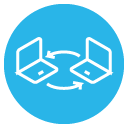
Sharing data between accounts
Snowflake’s new data sharing feature is designed to make it quick and easy to share objects (like tables) from a database with another Snowflake account. And since shared data doesn’t take up any additional storage space, you don’t need to worry about the storage costs. This makes it perfect for collaborating with team members, or customers who just need a small portion of your data.
Snowflake has a unique architecture that makes it possible to build a network of data providers and data consumers. One example is Snowflake’s data marketplace, which connects providers who have free or paid datasets with people who want to make use of them. With the marketplace, the shared dataset is immediately accessible inside your account, making queries straightforward.
Data exchange is another example of Snowflake’s multiple use cases. This feature allows members to collaborate on data, making it possible for partners or suppliers to share datasets with each other, and even business customers with their internal departments.
It’s hard for data consumers who don’t have Snowflake accounts to access data, so the company has made reader accounts available for them. Reader accounts are cost-effective because consumers are able to access shared data without becoming a Snowflake customer themselves.
Benefits of Snowflake Over Other Data Warehouses
Snowflake data warehouse offers a leading-edge design that’s modern, scalable, and dynamic. It outperforms competitors on many key metrics, and is available across cloud providers and regions worldwide. Snowflake Services
Snowflake is a resource-focused database. It has great features that make it easy for people to determine which data source is the most relevant, or even see if there is a better alternative to the chosen data source. With Snowflake, you’ll always be able to take on as much as you can handle. And if you have a query that takes some time, Snowflake won’t stop you from taking care of it.
Despite the stiff competition from Google and Amazon, Snowflake offers its own services for storing data. Data can be stored on these cloud providers but also on Microsoft Azure and Amazon Web Services. This means that businesses considering switching to Snowflake don’t have to worry about compatibility with any of the other data sources they are using because Snowflake supports them all.
Omnepresent is a foremost Snowflake consulting services provider that can help you leverage the platform’s true potential. We have Snowflake experts who have proven knowledge to help you transform your consumer experience.
Contact us today for a free Snowflake demo.
RECENT POSTS
CATEGORIES
